You can monitor your body heat during rest using wearable devices like the Oura Ring 4 or Fitbit Sense 2, which employ heat flux sensors to track core temperature fluctuations throughout sleep cycles. These devices measure the 1-2°F temperature drop that naturally occurs during sleep, helping optimize your bedroom environment at the recommended 65°F. AI-powered analytics integrate thermal data with heart rate patterns to detect sleep disorders and circadian rhythm disruptions. Continue exploring to discover how these insights transform your sleep quality.
Why Body Temperature Fluctuates During Sleep
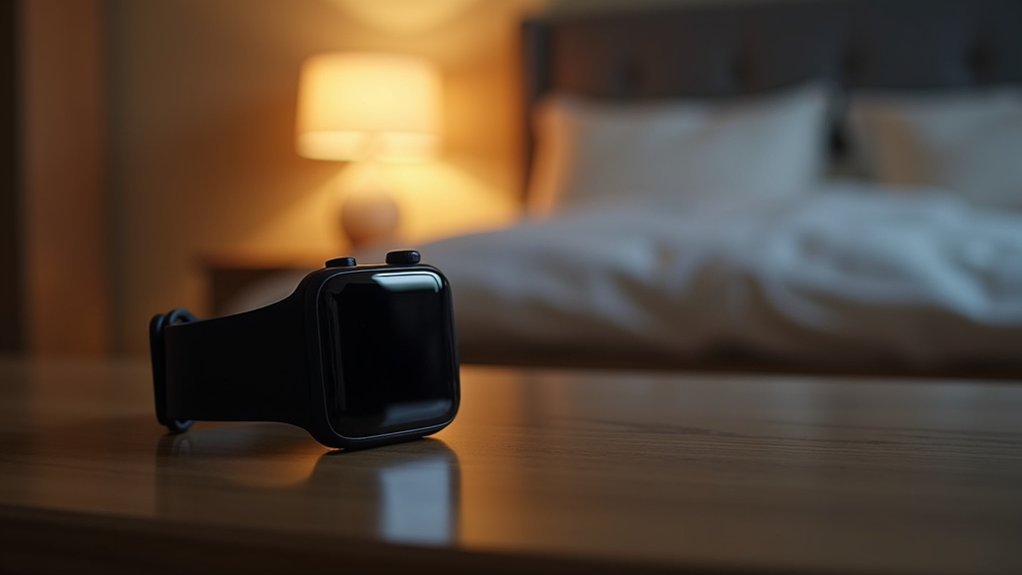
When you drift off to sleep, your body temperature naturally drops by one to two degrees Fahrenheit as part of your circadian rhythm’s nightly routine. Your hypothalamus orchestrates this temperature regulation, working alongside melatonin release triggered by reduced sunlight exposure.
This cooling process signals your body it’s time to rest and helps facilitate faster sleep onset.
During different sleep stages, your thermoregulation mechanisms behave differently. In NREM sleep, your body maintains temperature control through shivering and sweating, while REM sleep temporarily reduces these responses.
Hormonal fluctuations, particularly during menopause, can disrupt this natural cooling pattern. Medical conditions, excessive bedding, or an overly warm bedroom environment can also interfere with your body’s ability to regulate temperature effectively, potentially reducing deep sleep quality and causing nighttime awakenings. For optimal temperature regulation, experts recommend maintaining your bedroom at approximately 65 degrees Fahrenheit to prevent discomfort and promote quality sleep.
Core Temperature Vs Surface Temperature Measurement
While your smartwatch displays a single temperature reading, your body actually maintains two distinct thermal zones that tell different stories about your health. Core temperature reflects your internal organs’ heat at around 98.6°F, remaining remarkably stable through homeostasis. Surface temperature measures your skin’s outer layer, typically ranging from 89.6-95°F and fluctuating with environmental conditions.
| Aspect | Core Temperature | Surface Temperature |
|---|---|---|
| Stability | Highly regulated, minimal variation | Variable, responds to environment |
| Measurement | Invasive methods required | Non-invasive wearable sensors |
| Clinical Value | Critical health indicator | Trend analysis, comfort monitoring |
| Wearable Use | Limited feasibility | Ideal for continuous tracking |
Your wearable devices focus on surface monitoring because it’s practical for sleep tracking and provides valuable insights into thermoregulation patterns. The skin acts as your body’s largest organ and plays a significant role in temperature regulation by preserving or discharging heat as needed.
Heat Flux Sensor Technology for Sleep Monitoring
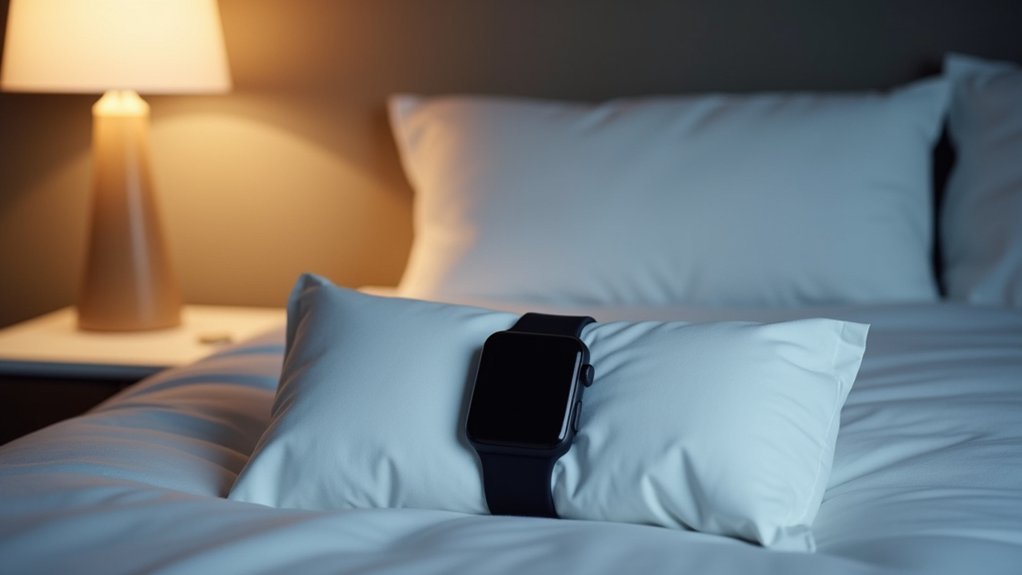
You’ll find that heat flux sensors revolutionize sleep monitoring by measuring thermal energy flow between your body and environment without invasive procedures.
These advanced wearables analyze your core temperature fluctuations to identify sleep stages, detect disturbances like night sweats, and track real-time thermal changes throughout the night. The CALERA® thermal sensing solution enables meticulous tracking of core body temperature during sleep, providing continuous data that helps optimize rest quality.
Understanding heat flux measurement basics, sleep temperature pattern analysis, and nighttime comfort optimization will help you choose the right technology for better sleep insights.
Heat Flux Measurement Basics
Heat flux sensors capture the rate of thermal energy transfer from your body to the surrounding environment by detecting temperature gradients across your skin surface.
These sensors use thermoelectric or thermistor elements arranged in layered structures to measure heat flow through conduction principles. You’ll find dual heat flux measurement techniques particularly effective, as they place sensors on both sides of a substrate to compensate for environmental temperature changes and improve accuracy.
Modern sensors are thin and flexible, making them ideal for continuous, non-invasive monitoring through wearable applications. The CORE sensor demonstrates this technology with compact dimensions of 40 mm x 50 mm x 8.35 mm and weighs just 12 grams.
They enable indirect assessment of your core body temperature by analyzing heat flux dynamics that reflect your internal thermal regulation. You can track subtle variations as small as 1°C across daily circadian cycles, providing valuable insights into your body’s thermal patterns during rest.
Sleep Temperature Pattern Analysis
During sleep, your body’s core temperature naturally drops by 1-2°C as part of your circadian rhythm, creating distinct thermal patterns that heat flux sensors can detect and analyze with remarkable precision.
These sensors identify different sleep stages by recognizing characteristic body heat variations between REM and non-REM phases. You’ll get continuous temperature measurements that reveal critical circadian rhythm fluctuations, essential for understanding your sleep quality.
Non-invasive devices like CALERA® monitor your temperature without disturbing sleep, eliminating environmental influences for accurate internal heat data. The high accuracy measurements enable researchers to conduct detailed human physiology studies focused on sleep patterns and thermal regulation.
This technology helps detect sleep disorders such as insomnia or circadian disruptions. You can use this thermal data to optimize your sleep environment by adjusting room temperature or bedding, ultimately supporting better sleep quality and overall wellness through personalized interventions.
Nighttime Comfort Optimization
While traditional sleep tracking relies on movement and heart rate data, heat flux sensors revolutionize nighttime comfort by measuring the actual heat transfer between your skin and environment.
These sophisticated sensors continuously monitor your core temperature fluctuations throughout the night, providing precise data about your body’s thermal responses during different sleep stages.
You’ll receive real-time insights into how environmental factors affect your sleep quality, enabling personalized adjustments to your bedroom temperature, bedding, or sleepwear.
The sensors detect subtle thermal changes linked to your circadian rhythm, helping identify disturbances before they fully wake you. Core body temperature naturally fluctuates by 1°C throughout each day, creating predictable patterns that optimize sleep timing.
- Environmental adaptation: Automatically adjust smart thermostats and bedding based on your thermal patterns
- Sleep stage optimization: Maintain ideal temperatures during deep sleep phases for maximum restoration
- Disturbance prevention: Identify thermal triggers causing night wakings before they disrupt your rest
FDA-Cleared Wearable Temperature Devices for Nighttime Use

You’ll want to understand FDA approval standards when selecting a wearable temperature device, as these clearances guarantee the device meets rigorous safety and accuracy requirements for medical-grade monitoring.
The accuracy of sleep monitoring depends heavily on continuous temperature sensors that can detect subtle physiological changes throughout your sleep cycles without compromising data quality. Advanced devices utilize broad-spectrum PPG technology alongside temperature monitoring to provide comprehensive biometric tracking during sleep.
Nighttime comfort features like wireless connectivity, extended battery life, and ergonomic designs in rings, patches, or wristbands allow you to monitor your body temperature all night without interruption or discomfort.
FDA Approval Standards
When you’re considering a wearable temperature device for nighttime monitoring, FDA clearance provides crucial validation that the device meets rigorous safety and efficacy standards.
The FDA’s 510(k) premarket notification pathway requires manufacturers to demonstrate substantial equivalence to legally marketed devices, ensuring your wearable delivers reliable temperature data during rest and sleep conditions.
You’ll find that FDA-cleared devices undergo extensive clinical validation programs that verify sensor accuracy and algorithm performance.
The clearance process evaluates how effectively temperature monitoring contributes to clinical decision-making, whether you’re tracking fertility windows or managing sleep health conditions. Advanced devices can provide 30 days of continuous monitoring with extended battery life, reducing the need for frequent charging interruptions during your sleep tracking periods.
- Clinical Integration: FDA clearance enables secure data transmission and healthcare provider coordination for thorough care management
- Algorithm Validation: Temperature interpretation algorithms must meet strict FDA standards for false positive/negative rates and data reliability
- Multi-Sensor Accuracy: Devices demonstrate reliable performance across multiple critical signs, including temperature, heart rate, and blood oxygen monitoring
Sleep Monitoring Accuracy
How accurately do FDA-cleared wearable temperature devices measure sleep compared to clinical gold standards?
Consumer sleep trackers now perform as well as or better than actigraphy, achieving moderate to fair agreement with polysomnography (Cohen κ=0.2–0.6) in sleep stage classification. However, no commercial sleep technology matches PSG’s precision for body temperature monitoring specifically.
FDA-cleared devices like the Happy Ring combine PPG, electrodermal activity, and accelerometers with machine learning for enhanced clinical relevance.
These devices averaged macro F1 scores of 0.49–0.50 across testing sites, indicating moderate performance with significant variability between institutions.
You’ll find accuracy varies considerably among different commercial technologies.
Expert recommendations emphasize ongoing validation studies to confirm body heat monitoring precision against medical standards before relying on these devices for clinical decision-making. Long-term data collection proves more feasible with consumer devices than traditional clinical testing methods.
Nighttime Comfort Features
Since FDA-cleared wearable temperature devices must function reliably throughout entire sleep cycles, manufacturers prioritize comfort features that minimize disruption to your natural rest patterns.
You’ll find these devices designed with lightweight materials and ergonomic shapes that conform to your body without creating pressure points. Rings like the Happy Ring and wrist wearables such as ActiGraph LEAP maintain low profiles that won’t catch on bedding or restrict movement during sleep.
The continuous skin temperature sensing operates passively, requiring no manual intervention while you sleep. Adjustable fits accommodate different body sizes, and soft materials prevent skin irritation during extended wear. Professional-grade devices like the Radius T maintain temperature accuracy of ±0.18°F throughout the night, ensuring reliable monitoring without compromising sleep quality.
- Seamless integration – Devices automatically sync overnight data without requiring your active participation
- Sleep-optimized design – Lightweight construction prevents awareness of wearing the device during rest
- Extended battery performance – Multi-day battery life eliminates nightly charging interruptions
AI-Powered Sleep Temperature Analytics
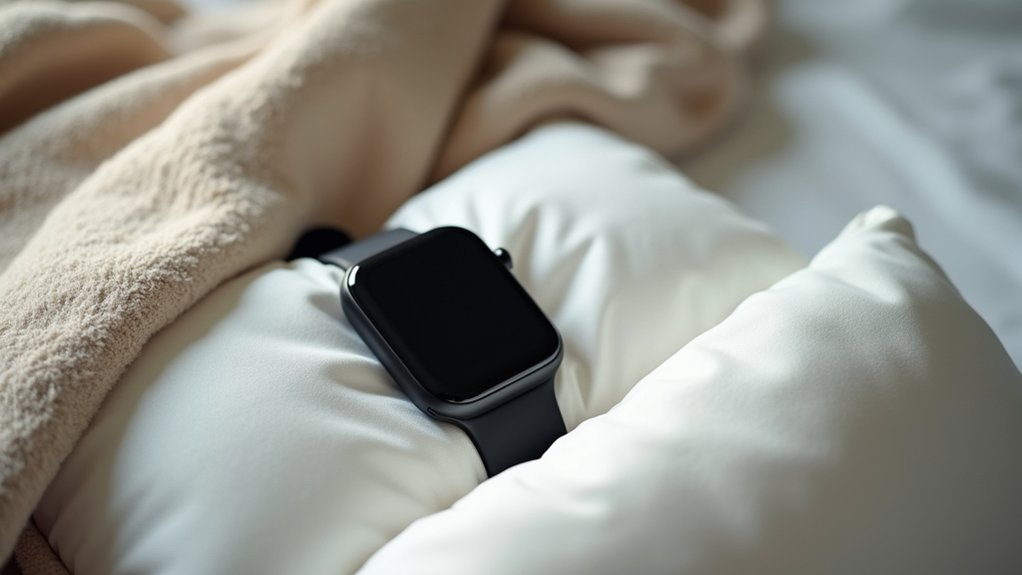
As you sleep, transformer-based AI models analyze your entire night’s worth of data, integrating brain activity, cardiac rhythms, respiratory patterns, and movement alongside temperature fluctuations to provide thorough sleep assessment.
These systems use self-supervised learning to identify clinical sleep features without human-labeled outcomes, improving accuracy in temperature pattern analysis.
Self-supervised learning enables AI sleep systems to detect clinical patterns autonomously, enhancing thermal analysis without requiring pre-labeled training data.
Deep learning platforms like Sleeptracker-AI® process environmental and physiological signals together, determining sleep stages with clinical-grade precision.
Your wearable’s AI correlates thermal data with heart rate variability and breathing anomalies to track how temperature changes affect sleep stage changes. Advanced systems can detect abnormal breathing patterns during sleep and automatically respond by adjusting head elevation to reduce disruptions.
Real-time systems adjust bed temperature from 55°F to 110°F per side, using predictive modeling to anticipate thermal needs before you experience discomfort, optimizing deep and REM sleep phases.
Optimal Placement and Comfort for Overnight Wear
You’ll find that chest strap positioning around 20cm below your armpit provides the most accurate core temperature readings while maintaining comfort during sleep.
Proper skin contact adhesion guarantees your sensor stays in place throughout the night without causing irritation or requiring frequent readjustment.
The key is selecting lightweight, breathable materials that won’t disrupt your natural sleep patterns or create pressure points that could wake you up. Advanced monitoring algorithms continuously analyze your physiological data throughout the night to track temperature fluctuations and sleep quality patterns.
Chest Strap Positioning
Proper chest strap positioning forms the foundation of accurate overnight body heat monitoring, requiring careful attention to anatomical placement and comfort considerations.
You’ll want to place the strap just below your sternum, positioning sensors directly beneath your pectoral muscles for ideal contact with your heart. Adjust the fit snugly but comfortably—tight enough to prevent slipping yet loose enough to allow natural breathing.
For women, sliding the strap under your bra’s bottom edge provides added stability and comfort.
Before wearing overnight, wet the electrodes with water or conductive gel to enhance conductivity. Verify the module sits right-side up and snaps securely without twisting. Multiple sensors can provide enhanced accuracy during extended monitoring periods.
- Choose breathable, hypoallergenic strap materials to prevent skin irritation during extended wear
- Test placement through movement simulation before sleep to confirm the strap won’t shift
- Select straps with moderate elasticity that accommodate chest expansion during breathing
Skin Contact Adhesion
While chest straps offer excellent heart rate monitoring, adhesive patches provide an alternative approach that eliminates strap adjustments and potential shifting during sleep.
You’ll need to prepare your skin properly by cleaning the area with alcohol wipes and ensuring it’s completely dry before application.
Choose a slim, lightweight device with a larger adhesive perimeter that extends beyond the sensor housing for maximum stability.
Apply the patch without wrinkles or air pockets to maintain direct thermal contact essential for accurate readings.
Your skin type affects adhesive performance, so you may need hypoallergenic materials if you’re sensitive to irritants.
Environmental factors like humidity and temperature can impact how well your adhesive patch performs throughout the night, requiring moisture-resistant designs for optimal monitoring.
Regularly check patch edges during multi-day wear to prevent thermal leakage that compromises data quality.
Sleep Disruption Prevention
During overnight monitoring, strategic device placement becomes critical since even minor discomfort can fragment your sleep cycles and compromise the thermal data you’re trying to collect.
You’ll want to choose wearables with lightweight materials and soft, flexible bands that won’t dig into your skin or restrict movement. Chest or torso placement offers the most stable contact for accurate core temperature readings, while wrist devices provide convenience but may shift during sleep. Ring-style monitors deliver unobtrusive monitoring but can limit hand movement.
Look for breathable fabrics and low-profile designs that won’t snag bedding or trap heat. Since sleep continuity is essential for accurate thermal monitoring, any device-related disruptions can create gaps in your temperature data and affect the overall assessment of your body’s natural heat regulation patterns.
- Prioritize multi-sensor integration to distinguish between actual thermal changes and movement artifacts that could trigger false alarms
- Choose devices with customizable silent alerts to prevent sleep interruption while maintaining safety monitoring capabilities
- Ensure 24/7 battery life to capture complete overnight thermal patterns without charging interruptions
Temperature Data Integration With Sleep Apps
As sleep tracking technology advances, your wearable device’s temperature sensors work alongside heart rate monitors and motion detectors to create a detailed picture of your sleep patterns.
Your sleep app aggregates this temperature data with other biosignals through cloud-based platforms, presenting user-friendly visualizations on your mobile device.
The app tracks temperature trends throughout the night, detecting patterns like your natural core body temperature drop that helps you fall asleep.
While temperature fluctuations contribute to sleep stage estimates, they can’t fully determine sleep phases alone. Device performance can be affected by individual characteristics such as skin tone and body composition, which may impact the accuracy of temperature readings.
Most popular devices like Oura Ring, Fitbit Sense, and Apple Watch sync temperature data through platforms like Apple Health or Google Fit, enabling extensive sleep reports that combine multiple biometric measurements for enhanced accuracy.
Detecting Sleep Disorders Through Temperature Patterns
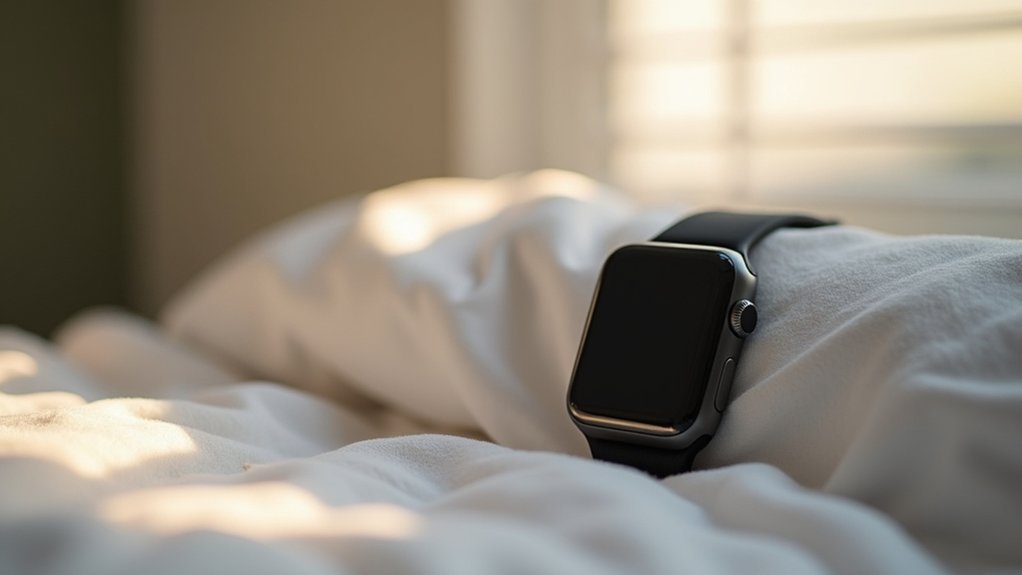
Beyond basic sleep tracking, temperature monitoring reveals distinctive patterns that can help identify potential sleep disorders before they markedly impact your health. Your wearable device can detect abnormal temperature fluctuations that indicate disrupted sleep cycles, irregular vasodilation patterns, or circadian rhythm disorders.
When your core body temperature doesn’t follow its natural 1°C drop during sleep, or when wrist temperature patterns deviate from normal sleep-wake cycles, these anomalies suggest underlying issues.
Machine learning algorithms analyze your temperature data to identify abnormal patterns that correlate with specific sleep disorders. This early detection capability allows you to address problems proactively. Disrupted temperature regulation can also indicate compromised energy homeostasis, which may signal broader metabolic issues affecting sleep quality.
- REM vs Non-REM Detection: Different sleep stages show distinct thermal patterns your device can recognize
- Circadian Disruption Alerts: Irregular temperature rhythms indicate misaligned sleep-wake cycles
- Breathing-Related Disorders: Temperature changes reflect altered breathing patterns during sleep disturbances
Circadian Rhythm Tracking via Body Heat
Your body’s natural temperature fluctuations create a precise biological clock that wearable devices can now track with remarkable accuracy.
Heat-flux sensors attached to your sternum or torso continuously monitor core body temperature patterns, outperforming basic skin temperature measurements for circadian assessment. These devices use AI algorithms to estimate your circadian phase from 24-hour temperature data, transmitting information to cloud platforms for analysis.
You’ll get insights into your personal circadian rhythm amplitude and timing, enabling optimized medication scheduling and chronotherapy. The technology proves especially valuable if you’re a shift worker with irregular schedules.
Your core temperature reaches its lowest point in the early morning hours, serving as a key marker for identifying your natural circadian phase and sleep-wake cycle alignment.
Remote Patient Monitoring During Rest Periods
While you sleep, wearable heat sensors transform your rest periods into essential health monitoring opportunities through remote patient monitoring (RPM) systems.
These unobtrusive devices continuously track your body temperature, heart rate, and other critical signs without disrupting your sleep. Your data transmits wirelessly to healthcare providers who can detect early warning signs of health changes, from nocturnal temperature fluctuations to cardiac events.
You’ll experience fewer nighttime interruptions while maintaining constant medical oversight. This continuous monitoring reduces your need for frequent hospital visits and provides your care team with extensive health data. Medicare now provides coverage for RPM services, making this technology more accessible to patients who need ongoing health monitoring.
Studies show RPM users have lower hospitalization rates and improved safety outcomes.
- Early Detection Advantage: Continuous monitoring catches physiological changes before they become serious health emergencies
- Enhanced Sleep Quality: Non-invasive sensors eliminate disruptive manual temperature checks throughout the night
- Reduced Healthcare Costs: Remote monitoring decreases emergency visits and hospital readmissions considerably
Comparing Wearable Sleep Temperature Devices
Which wearable sleep temperature device best fits your nighttime monitoring needs? You’ll find distinct advantages across different form factors. Rings like the Oura Ring 4 offer lightweight, discreet monitoring with multi-day battery life. Wristbands such as Fitbit Sense 2 provide extensive metrics but may feel bulkier during sleep. Headbands and masks focus on brain activity alongside temperature tracking, though face-worn devices aren’t comfortable for everyone.
| Device Type | Accuracy Level | Comfort Rating |
|---|---|---|
| Rings | Fair-Moderate (κ=0.2-0.6) | High |
| Wristbands | Moderate (κ=0.4-0.6) | Medium |
| Headbands/Masks | Variable | Low-Medium |
Consider that wristbands often overestimate sleep duration by 20-30 minutes, while rings provide less intrusive monitoring. Your choice depends on balancing accuracy needs with overnight comfort preferences. Recent tariff impacts may increase wearable device prices by approximately 20% as manufacturers adjust to new import costs.
Maximizing Sleep Quality Through Temperature Insights
Understanding your body’s natural temperature patterns reveals powerful opportunities to enhance sleep quality. Your core body temperature naturally decreases during sleep, while slightly warming your skin temperature can greatly improve rest, especially as you age.
Understanding your body’s thermal rhythms unlocks better sleep by leveraging natural temperature changes that occur nightly.
You’ll achieve ideal sleep when your bed climate maintains 32°C to 34°C with 40-60% humidity. Starting your bedtime routine with a warm bath triggers vasodilation, helping you fall asleep faster by facilitating this natural temperature shift.
Your wearable device monitors these thermal changes, providing personalized insights about your sleep-temperature relationship. By tracking both core and peripheral temperature fluctuations, you can identify patterns that either enhance or disrupt your sleep quality. Poor temperature regulation during sleep creates a significant barrier to achieving restorative rest, as sleeping too hot ranks as the third most common cause of sleep disruption.
- Monitor your skin temperature trends to enhance sleep onset timing
- Adjust your bedroom environment based on personal temperature data patterns
- Use pre-sleep warming strategies when your device indicates less than ideal thermal conditions
Frequently Asked Questions
How Long Does the Battery Last on Wearable Temperature Monitors During Sleep?
You’ll get 6-14 days of battery life during sleep monitoring, depending on your device. Sleep modes extend battery considerably compared to continuous transmission. Most wearables use power-saving features that optimize monitoring while you’re resting.
Can I Shower or Swim While Wearing a Body Heat Monitor?
You can shower or swim with waterproof body heat monitors rated IPX7 or IPX8. Check your device’s specifications first, then rinse with fresh water and soap afterward for proper maintenance.
What’s the Price Range for Fda-Cleared Wearable Temperature Monitoring Devices?
You’ll find FDA-cleared wearable temperature monitors ranging from $39/month subscriptions for basic BBT thermometers to $279-$319 for premium devices like Ava bracelets with additional health tracking features.
Do Wearable Temperature Monitors Work Accurately for Children and Infants?
You’ll find limited clinical data supporting accuracy for infant wearables. Some devices show acceptable performance within 2% SpO₂ and 3.5 bpm, but motion and improper placement can decrease accuracy considerably.
How Often Should I Replace or Calibrate My Wearable Temperature Sensor?
You don’t need regular replacement intervals for most wearable temperature sensors. Replace them when readings become erratic, you see physical damage, or get error messages indicating sensor failure.
In Summary
You’ll discover that monitoring your body temperature during rest transforms how you understand your sleep patterns. By choosing FDA-cleared wearables with heat flux sensors, you’re gaining precise insights into your circadian rhythms and sleep quality. Don’t overlook the power of AI analytics to interpret your temperature data and identify optimization opportunities. You’re now equipped to make informed decisions that’ll enhance your nightly recovery and overall health outcomes.

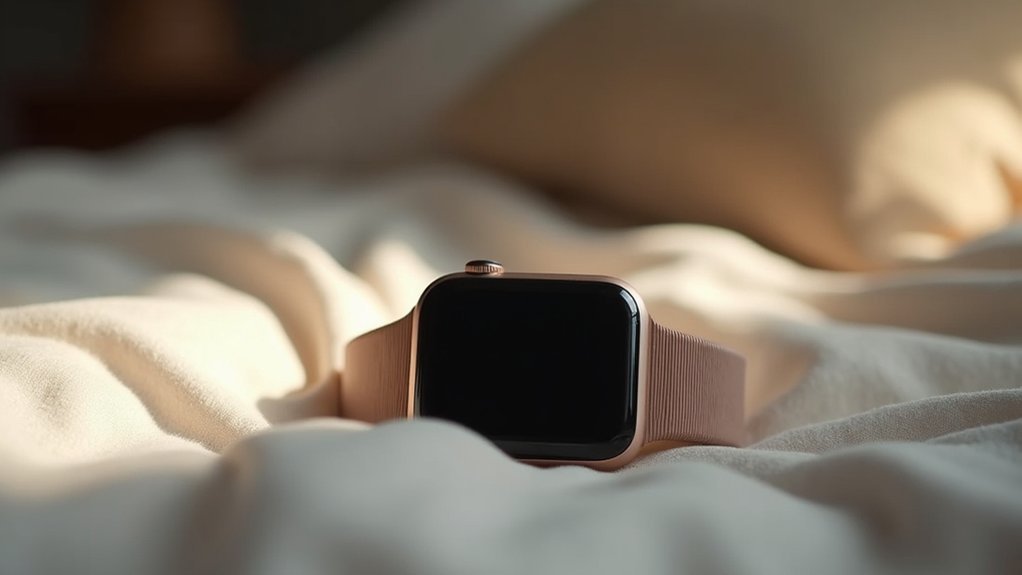



Leave a Reply